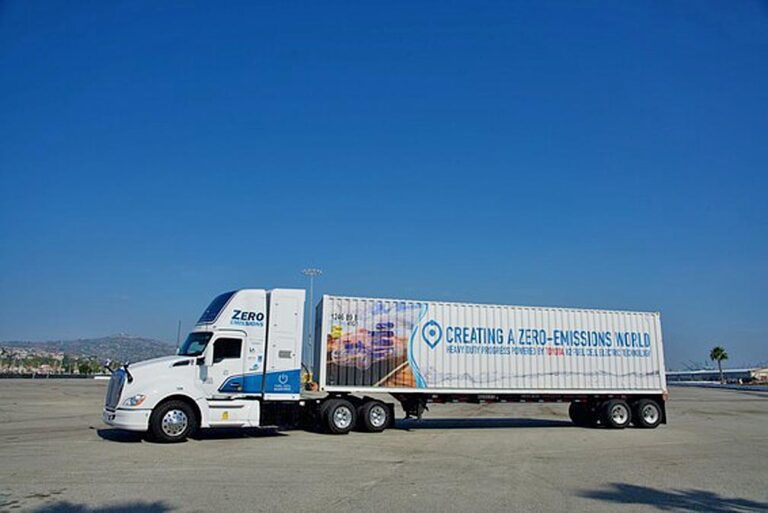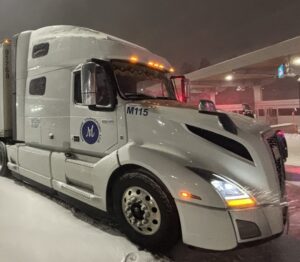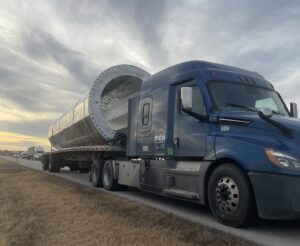SACRAMENTO, Calif. — The California Air Resources Board (CARB) has fast-tracked a new rule to clamp down on pollutants from heavy-duty trucks and require deployment of zero-emission vehicles (ZEVs).
Leaders say it’s a first-of-its-kind requirement that will create a phased-in transition toward zero-emission medium-and heavy-duty trucks.
The approval came on Friday, April 28.
Under the new rule, fleet owners operating vehicles for private services, such as last-mile delivery and federal fleets, must begin their transition toward zero-emission vehicles starting in 2024.
The rule cannot be implemented without approval by the U.S. Environmental Protection Agency. But it’s related to standards the Biden administration already approved last month to phase out diesel-powered box trucks, semitrailers and large passenger pick-ups. If the EPA approves California’s rule, other states could later adopt the same standards.
According to a news release from CARB, the new rule, known as Advanced Clean Fleets, “helps put California on a path toward accomplishing Gov. Gavin Newsom’s goal of fully transitioning the trucks that travel across the state to zero-emissions technology by 2045.”
The rule includes the ability to continue operating existing vehicles through their useful life.
Additionally, state leaders say the new rule is expected to generate $26.6 billion in health savings from reduced asthma attacks, emergency room visits and respiratory illnesses.
The state also claims that fleet owners will save an estimated $48 billion in their total operating costs from the transition through 2050.
The American Trucking Associations President and CEO Chris Spear said in a statement that the decision to force motor carriers to purchase zero-emission vehicles ignores the fact that these types of trucks are early-stage technologies and the infrastructure to support them does not exist.
“Today, an unelected Board in California voted to force trucking companies to buy zero-emission trucks. Fleets are just beginning to understand what it takes to successfully operate these trucks, but what they have learned so far is they are significantly more expensive, charging and refueling infrastructure is nonexistent, and ZEVs are not necessarily a one-for-one replacement — meaning more trucks will be needed on California roads to move the same amount of freight,” Spear said.
Spear added that California is setting unrealistic targets and unachievable timelines that could lead to higher prices for the goods and services delivered to the state and fewer options for consumers.
“As it becomes clear that California’s rhetoric is not being matched by technology, we hope the Board will reverse course and allow trucking companies the freedom to choose the clean technologies that work best for their operations,” Spear said. “ATA-member companies work tirelessly to deliver the nation’s freight while deploying the cleanest technologies available. Over the past 35 years, those efforts have produced a 98% reduction in truck emissions. We continue to say, ‘Yes’ to advancing cleaner technologies, but achievable targets and realistic timelines matter.”
Truckload Carriers Association President Jim Ward echoed Spear, writing in a statement that “Pushing trucking companies — who are the central link in the supply chain — towards the adoption of vehicles that are still early in development and fraught with limitations is premature and irresponsible.”
Ward added: “As an industry, truckload stands ready to be at the forefront of a proactive, but realistic approach to the rollout of electric commercial vehicles that aid the protection of our environment and ensure our essential equipment is reliable, affordable, and supported by sound infrastructure. The adoption of this regulation signals a lack of awareness regarding the present gap between goals and current achievability – which if ignored will inevitably lead to supply chain disruptions that will affect the consumer and their pocketbook.”
Ward further wrote that “Calculated planning, realistic expectations and practical solutions are the answer towards advancing clean technologies. Today’s adoption of the ‘Advanced Clean Fleets’ regulation only proves that none of those answers were considered in this misguided transition.”
While trucks represent only 6% of the vehicles on California’s roads, they account for over 35% of the state’s transportation generated nitrogen oxide emissions and a quarter of the state’s on-road greenhouse gas emissions, the CARB news release noted.
Sam Wilson, an analyst with the Union of Concerned Scientists, said in a statement the technology is available to start transitioning toward electric trucks.
“We need this standard to accelerate the necessary phase-out of fossil-fueled trucks that are fouling our air,” Wilson said.
California communities that sit near trucking corridors and warehouse locations with heavy truck traffic have some of the worst air in the nation, CARB officials have said.
California is set to invest almost $3 billion between 2021-25 in zero-emission trucks and infrastructure. This investment is a part of a $9 billion multi-year, multi-agency zero-emissions vehicle package to equitably decarbonize the transportation sector that was agreed upon by the Governor and the Legislature in 2021.
“We have the technology available to start working toward a zero-emission future now,” said CARB Chair Liane Randolph. “The Advanced Clean Fleets rule is a reasonable and innovative approach to clean up the vehicles on our roads and ensure that Californians have the clean air that they want and deserve. At the same time, this rule provides manufacturers, truck owners and fueling providers the assurance that there will be a market and the demand for zero-emissions vehicles, while providing a flexible path to making the transition toward clean air.”
Yana Garcia, California’s secretary for environmental protection, said her state is leading by example with these new measures to slash air pollution from heavy-duty trucks.
“Where you live, work or go to school should not determine the quality of the air you breathe,” Garcia said. “The Advanced Clean Fleets rule brings California one step closer to addressing historic inequities that have placed some communities at the epicenter of environmental pollution and the resulting health consequences, while accelerating our transition to a zero-emission future.”
NEW RULE AT A GLANCE
Drayage trucks will need to be zero-emissions by 2035.
All other fleet owners will have the option to transition a percentage of their vehicles to meet expected zero-emission milestones, which gives owners the flexibility to continue operating combustion-powered vehicles as needed during the move toward cleaner technology, according to CARB officials.
The flexibility is intended to take into consideration the available technology and the need to target the highest-polluting vehicles. For example, last mile delivery and yard trucks must transition by 2035, work trucks and day cab tractors must be zero-emission by 2039, and sleeper cab tractors and specialty vehicles must be zero-emission by 2042.
The rule also allows fleet owners to receive exemptions based on available technology to make sure fleet owners continue to replace their older polluting trucks with ones that have the cleanest engines in the nation. There are already about 150 existing medium- and heavy-duty zero-emission trucks that are commercially available in the U.S. today.
The Advanced Clean Fleets rule includes an end to combustion truck sales in 2036, a first-in-the-world requirement that factors in public commitments to transition to zero-emission technology by truck manufacturers, potential cost savings for fleets and accelerated benefits for California communities, according to CARB.
The rule also provides fleet owners flexibility and provides regulatory certainty to the heavy-duty market.
“An analysis of the sales and purchase requirements estimates that about 1.7 million zero-emission trucks will hit California roads by 2050,” according to the CARB news release. “To support the needed infrastructure and services to make this transition, agencies across government have committed to the Zero-Emission Infrastructure Joint Agency Statement of Intent.”
Advanced Clean Fleets follows the 2020 adoption of the Advanced Clean Trucks rule, which put in place a requirement for manufacturers to increase the sale of zero-emission trucks and its waiver was recently granted by the Biden Administration’s Environmental Protection Agency.
The Associated Press contributed to this report.
The Trucker News Staff produces engaging content for not only TheTrucker.com, but also The Trucker Newspaper, which has been serving the trucking industry for more than 30 years. With a focus on drivers, the Trucker News Staff aims to provide relevant, objective content pertaining to the trucking segment of the transportation industry. The Trucker News Staff is based in Little Rock, Arkansas.















